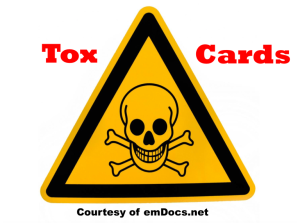Authors: Rosa Malloy Post, MD (Emergency Medicine PGY-3, Carolinas Medical Center, Charlotte, NC); Anna Dulaney, PharmD (Clinical Toxicologist, Department of Emergency Medicine, Carolinas Medical Center, Charlotte, NC); Christopher Counts, MD (Medical Toxicology Fellow, Rutgers New Jersey Medical School, Newark, NJ) // Reviewed by: Cynthia Santos, MD (Emergency Medicine Attending, Medical Toxicologist, Rutgers New Jersey Medical School); Alex Koyfman, MD (@EMHighAK); Brit Long, MD (@long_brit)

Case:
A 22-year-old male with no past medical history presents after being found unresponsive in his car with a respiratory rate of 3 breaths per minute. In the field, he was given 4 mg intranasal (IN) naloxone and rescue breaths via bag valve mask. In the ED, he develops recurrent respiratory depression and hypoxia to 80%. He is administered 2mg intravenous (IV) naloxone and shortly after develops precipitated withdrawal with altered mental status, diaphoresis, vomiting, and diarrhea.
Questions:
- What is the optimal naloxone dosing strategy to treat respiratory depression while minimizing the risk of precipitating withdrawal?
- What are the pharmacokinetics of naloxone and how do they vary by route of administration?
- When should a naloxone infusion be considered?
- Is there an ideal observation period in the emergency department after reversal with naloxone?
Background:
- Fentanyl has contributed to a significant increase in drug overdose deaths in recent years.1
- Most “heroin” in the United States actually contains fentanyl and fentanyl analogs. Fentanyl has also been found in counterfeit pills and other drugs such as cocaine.2,3
- Fentanyl and its analogs are far more potent than morphine. Additionally, high lipophilicity leads to an increased volume of distribution and prolonged clearance with regular use.4,5
- Naloxone is a competitive antagonist at all opioid receptor sites; however, its highest affinity is for the mu-opioid receptor. It is a synthetic N-allyl derivative of oxymorphone, an opioid receptor agonist similar in structure to morphine. Replacing the N-17 methyl group results in the formation of naloxone and naltrexone. Naloxone reverses the analgesic, respiratory, sedative, and miotic effects of opioids.6

Image 1: Structure of naloxone. Image courtesy of Wikimedia Commons.
Naloxone Dosing Strategy: Start Low, Titrate Up
- In opioid-dependent or unknown patients, start with a lower dose (0.04 mg IV)7
- If there is no response, repeat the dose of 0.04mg in two minutes.
- If there is still no response, titrate up with small increments such as 0.2 mg, 0.4mg, 2mg, and finally 10mg (rarely needed).
- Titrate to adequate respiratory rate (RR > 8) and tidal volume.
- Starting lower and titrating up decreases the chance of precipitating withdrawal, which can be life-threatening.
Adverse Effects: Precipitated Withdrawal
- Rapid reversal with naloxone can cause a catecholamine surge that can lead to hypertension, tachycardia, and cardiac dysrhythmias.
- Pulmonary complications include aspiration of vomit in patients who are not protecting their airway. Precipitated withdrawal can also contribute to the development of pulmonary edema through increased negative thoracic pressure against a closed glottis.8,9
- Life-threatening complications can occur.
- A prospective study of 453 patients who were admitted after receiving naloxone reported life-threatening complications in over 1% of heroin-overdosed patients. These included seizures, delirium, ARDS, hypotension, hypertension, and aspiration. The median IV dose administered was 0.2mg, and the median IM dose was 0.2 mg.10
Rationale for Starting Low and Titrating Up
- Large doses of naloxone can precipitate withdrawal.
- Although a dose of 0.4 mg IV is often referenced as a “standard dose” to reverse respiratory depression in opioid naïve patients, this dose can precipitate withdrawal in opioid-dependent patients.
- Precipitated opioid withdrawal from naloxone administered to an opioid-dependent person not only causes patient distress but also complicates patient care and can occasionally be life-threatening.
Route of Administration and Pharmacokinetics 7,11-14
[table id=15 /]
Pediatric dosing:
- Children < 5 years old or 20 kg or less: 0.1 mg/kg IV or IO11
- Children > 5 years old or 20 kg or greater: 2 mg IV or IO11
Naloxone Infusions:
- Infusions can be considered for recurrent episodes of apnea or respiratory depression after an initial response to naloxone.
- Continuous infusions start at two-thirds of the total effective dose per hour.15
- Titrate to patient response:
- If the patient develops withdrawal, pause the infusion until the effects subside, and restart the infusion at half of the initial rate.
- If the patient develops recurrent respiratory depression, re-administer the effective bolus dose and increase the infusion by half the initial rate. can titrate as needed to patient response. Others prefer repeated bolus dosing of naloxone, as patients receiving naloxone infusions continue to require frequent reassessments to monitor for recurrent respiratory depression and precipitated withdrawal.
OK, now they’re awake, breathing, and want to go home. How long should they stay in the ED?
- The answer is, “it’s complicated.” Host factors, drug route of administration, quantity, and type of opioid cause significant variations that make predicting the right amount of observation time difficult.
- Patients should be monitored for recurrent respiratory depression for at least two hours after naloxone, as the duration of action of some opioids is longer than that of naloxone. Patients who only required one dose of naloxone, showed no signs of hypoxia, and were not exposed to a long-acting opioid may be discharged after this observation period.16
- Patients who required multiple doses, were exposed to long-acting or novel opioids, or were treated with a naloxone infusion should be monitored for at least 4-6 hours after the last dose of naloxone or cessation of infusion.
- Both decision-making tools and clinical gestalt have been shown to have low sensitivity in predicting adverse reactions after overdose.17
- Clinicians should consider the patient’s ability to have a guaranteed safe disposition. Data suggest that the first month and in particular the first 48 hours after overdose carry a significant risk of death.18
- Data also suggest there is a decrease in all-cause and opioid-related mortality one year after overdose for those who initiate either buprenorphine or methadone treatment.19 Finally, engaging patients in harm reduction strategies before discharge is vital to a safe disposition.
Case Resolution:
The patient’s precipitated withdrawal resulted in aspiration pneumonitis and hypertension. He required multiple doses of buprenorphine to treat the withdrawal and recovered after a brief hospitalization.
Clinical Pearls:
- Naloxone is lifesaving in opioid overdoses.
- Use smaller initial doses (0.04 mg IV) and escalate as needed; large doses can precipitate withdrawal.
- Precipitated opioid withdrawal causes patient distress, complicates care, and can be life-threatening.
- Rarely, patients with recurrent respiratory depression may need a maintenance infusion at ⅔ of the total effective bolus dose per hour.
- The observation period after naloxone depends on the initial presentation and the type of opioid.
- The days after overdose are associated with an increased risk of mortality. Use the observation period to engage patients regarding substance use treatment and support services.
References
- Spencer MR, Miniño AM, Warner M. Drug overdose deaths in the United States, 2001–2021. NCHS Data Brief, no 457. Hyattsville, MD: National Center for Health Statistics. 2022. DOI:https://dx.doi.org/10.15620/cdc:122556
- O’Donnell J, Tanz LJ, Miller KD, et al. Drug Overdose Deaths with Evidence of Counterfeit Pill Use – United States, July 2019-December 2021. MMWR Morb Mortal Wkly Rep. 2023;72(35):949-956. Published 2023 Sep 1. doi:10.15585/mmwr.mm7235a3
- Park JN, Rashidi E, Foti K, Zoorob M, Sherman S, Alexander GC. Fentanyl and fentanyl analogs in the illicit stimulant supply: Results from U.S. drug seizure data, 2011-2016. Drug Alcohol Depend. 2021;218:108416. doi:10.1016/j.drugalcdep.2020.108416
- Comer SD, Cahill CM. Fentanyl: Receptor pharmacology, abuse potential, and implications for treatment. Neurosci Biobehav Rev. 2019;106:49-57. doi:10.1016/j.neubiorev.2018.12.005
- Huhn AS, Hobelmann JG, Oyler GA, Strain EC. Protracted renal clearance of fentanyl in persons with opioid use disorder. Drug Alcohol Depend. 2020;214:108147. doi:10.1016/j.drugalcdep.2020.108147
- Jasinski, D. R., W. R. Martin, and C. A. Haertzen. The human pharmacology and abuse potential of N-allylnoroxymorphone (naloxone). Journal of Pharmacology and Experimental Therapeutics 157.2 (1967): 420-426. PMID
- K, Nelson LS. Reversal of Opioid-Induced Ventilatory Depression Using Low-Dose Naloxone (0.04 mg): a Case Series. J Med Toxicol. 2016 Mar;12(1):107-10. doi: 10.1007/s13181-015-0499-3. PMID: 26289651; PMCID: PMC4781798.
- Kienbaum P, Thürauf N, Michel MC, Scherbaum N, Gastpar M, Peters J. Profound increase in epinephrine concentration in plasma and cardiovascular stimulation after mu-opioid receptor blockade in opioid-addicted patients during barbiturate-induced anesthesia for acute detoxification. Anesthesiology. 1998 May;88(5):1154-61. doi: 10.1097/00000542-199805000-00004. PMID: 9605673.
- Al-Azzawi M, Alshami A, Douedi S, Al-Taei M, Alsaoudi G, Costanzo E. Naloxone-Induced Acute Pulmonary Edema is Dose-Dependent: A Case Series. Am J Case Rep. 2021 Mar 17;22: e929412. doi: 10.12659/AJCR.929412. PMID: 33730013; PMCID: PMC7983320.
- Osterwalder JJ. Naloxone–for intoxications with intravenous heroin and heroin mixtures–harmless or hazardous? A prospective clinical study. J Toxicol Clin Toxicol. 1996;34(4):409-416. doi:10.3109/15563659609013811
- Micromedex Drug Information, Naloxone. Available at: http://micromedex.com/Accessed October 19, 2023
- Kelly A, Kerr D, Dietze P, et al. Randomised Trial of Intranasal Versus Intramuscular Naloxone in Prehospital Treatment for Suspected Opioid Overdose. Med J Aust, 2005, 182(1):24-7.[PMID: 15651944]
- Robertson TM, Hendey GW, Stroh G, et al. Intranasal Naloxone is a Viable Alternative to Intravenous Naloxone for Prehospital Narcotic Overdose. Prehosp Emerg Care, 2009, 13(4):512-5. [PMID: 19731165]
- Product Information: Narcan(R), naloxone. Endo Pharmaceuticals, Chadds Ford, PA, 2001.
- Goldfrank L, Weisman RS, Errick JK, Lo MW. A dosing nomogram for continuous infusion intravenous naloxone. Ann Emerg Med. 1986;15(5):566-570. doi:10.1016/s0196-0644(86)80994-5
- Clarke SFJ. Naloxone in opioid poisoning: walking the tightrope. Emergency Medicine Journal. 2005;22(9):612-616. doi:10.1136/emj.2003.009613
- Clemency BM, Eggleston W, Shaw EW, Cheung M, Pokoj NS, Manka MA, Giordano DJ, Serafin L, Yu H, Lindstrom HA, Hostler D. Hospital Observation Upon Reversal (HOUR) With Naloxone: A Prospective Clinical Prediction Rule Validation Study. Acad Emerg Med. 2019 Jan;26(1):7-15. doi: 10.1111/acem.13567. Epub 2018 Dec 28. PMID: 30592101.
- Weiner SG, Baker O, Bernson D, Schuur JD. One-Year Mortality of Patients After Emergency Department Treatment for Nonfatal Opioid Overdose. Ann Emerg Med. 2020 Jan;75(1):13-17. doi: 10.1016/j.annemergmed.2019.04.020. Epub 2019 Jun 20. PMID: 31229387; PMCID: PMC6920606.
- Larochelle MR, Bernson D, Land T, Stopka TJ, Wang N, Xuan Z, Bagley SM, Liebschutz JM, Walley AY. Medication for Opioid Use Disorder After Nonfatal Opioid Overdose and Association with Mortality: A Cohort Study. Ann Intern Med. 2018 Aug 7;169(3):137-145. doi: 10.7326/M17-3107. Epub 2018 Jun 19. PMID: 29913516; PMCID: PMC6387681.





